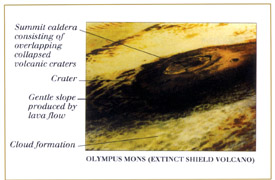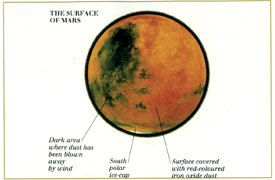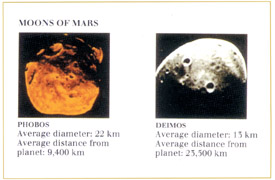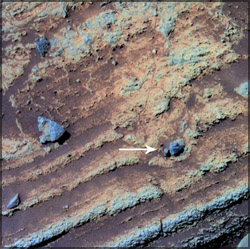Mars exploration
by Indu Umanga Dissanayake
Mars, known as the red
planet, is the fourth planet from the sun and the outer most rocky
planet. In the 19th century, astronomers first observed what were thought to be signs
of life on Mars. These signs included apparent canal-like marking on the
surface, and dark patches that were thought to be vegetarians.
19th century, astronomers first observed what were thought to be signs
of life on Mars. These signs included apparent canal-like marking on the
surface, and dark patches that were thought to be vegetarians.
It is now known that the "Canals" are an optical illusion, and the
dark patches are areas where the red dust that covers most of the planet
has been blown away. The fine dust particles are often whipped up by
winds into dust storms that occasionally obscure almost all the surface.
Residuals dust in the atmosphere gives the Martian sky a pinkish hue.
The northern hemisphere of Mars has many large plains formed of
solidified volcanic lava, whereas the southern hemisphere has many
craters and large impact basins. There are also several huge, extinct
volcanoes, including Olympus mons.
Picture no: 18B
Which, at 600 kilometres across and 25 kilometres high, is the
largest known volcano in the solar system.

Picture no: 18C
The surface also has many canyons and branching channels. The canyons
were formed by movements of the surface crust, but the cannels are
thought to have been formed by following water that has now dried up.
The Martian Atmosphere is much thinner than Earth's with only a few
clouds and morning mists. Mars has two tiny, irregularly shaped moons
called Phobos and Deimos.
Picture no: 18D
Their small size indicates that they may be asteroids that have been
captured by the gravity of mars.
The latest explorations of Mars from NASA finds evidence of Ancient
volcanic explosion at "Home Plate" a plateau of layered bedrock approximately 2 meters (6 feet) high within
the "Inner Basin" of Colombia Hills, of mars.
plateau of layered bedrock approximately 2 meters (6 feet) high within
the "Inner Basin" of Colombia Hills, of mars.
This is the first explosive volcanic deposit identified with a high
degree of confidence by the NASA scientist.
There is strong evidence that those layers are from a volcanic
explosion, said Steve Squyres of Comell University.
Evidence shows the Home Plate is dominated by basaltic rocks. "When
basalt erupts, it often does so as very fluid lava, rather than erupting
explosively," Squyres said.
Scientists suspect that the explosion that formed Home Plate may have
been caused by an interaction of basaltic lava and water. Basaltic have
to cause an explosion is for it to come in to contact with water it's
the pressure from the steam that causes it to go boom.
Picture no: 18E
The lower course grained unit shows granular textures toward the
bottom of the image and massive textures. Also shown in this false colour view is a feature interpreted to be a
"Bomb Sag" which is 4 centimetres across.
Also shown in this false colour view is a feature interpreted to be a
"Bomb Sag" which is 4 centimetres across.
The high chlorine contact of the rocks, which might indicate that
basalt had come in to contact with a brine.
One of the strongest pieces of evidence for Home Plate is a "Bomb
Sag" preserved in layered rocks on the lower slopes of the plateau. Bomb
sags form in volcanic explosions on earth when rocks ejected sky ward by
the explosion fall in to soft deposits, deforming them as they land.
Exploration of Home Plate will focus largely on testing the idea,
that water was involved in its formation process.
Sharp views show ground Ice on mars is patchy and variable depths to
ice on mars mapped. Mars southpole ice deep and wide new measurements of
mars southpolar region indicate extensive frozen water. The polar region
contains to cover enough frozen.
The whole planet in a liquid layer approximately 11 meters (36 feet)
deep. NASA mars explorers discovered Sulfur-Rich Soil, some bright Martian Soil, containing lots of Sulfur
and a Trace of Water intrigues researchers.
Sulfur-Rich Soil, some bright Martian Soil, containing lots of Sulfur
and a Trace of Water intrigues researchers.
NASA-Backed researchers are refining a tool that could not only check
for the faintest traces of life's molecular building blocks on mars, but
could also determine whether they have been produced by anything alive.
Researchers and explorers are working hard to improve life on earth
and extend life beyond our home planet. |
